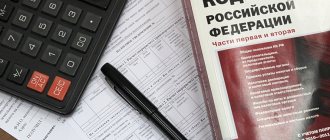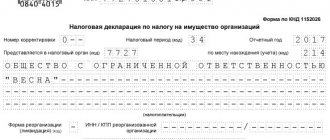Objects of taxation.
Property tax for individuals is levied on the following owned objects located within a municipal entity (city of federal significance):
- residential buildings;
- rooms and apartments;
- unfinished construction projects;
- unified real estate complexes;
- garages and parking spaces;
- other buildings, structures and premises.
Residential buildings also include objects located on land plots for personal subsidiary farming, summer cottage farming, gardening, vegetable gardening, and individual housing construction.
At the same time, property included in the common property of an apartment building is not taxed.
Tax base for property tax.
The tax base is determined based on the cadastral value of objects in those constituent entities of the Russian Federation where a single start date for the application of this procedure has been established. The transition of all entities to determine the tax base based on the cadastral value of taxable objects will take place before the beginning of 2020.
In those constituent entities of the Russian Federation where the transition has not yet been made, the tax base is determined for each object as its inventory value . Its calculation is carried out taking into account the deflator coefficient based on the data on inventory value submitted to the tax authorities.
The inventory value of taxable items is not taken into account from January 1, 2020.
The rules for applying cadastral value have been established since 2021 and are as follows:
Deflator coefficient for 2021 for UTII
The K1 deflator coefficient for organizations and entrepreneurs on UTII adjusts the size of the basic profitability for all types of activities on the imputation. In 2021, the coefficient is 1.915, for 2020 its size is 2.005 (Order of the Ministry of Economic Development of Russia dated December 10, 2019 No. 793). Thus, the tax burden of most companies on UTII will increase.
There is also a K2 coefficient. On the contrary, it is designed to reduce the amount of tax, since its amount cannot be more than 1. But the coefficient K2 is set by local authorities for certain categories of taxpayers. There is no single K2 indicator.
Let us recall that the State Duma proposed, when calculating the deflator coefficient for UTII for 2021, to take into account changes in consumer prices in an amount not exceeding the inflation rate. Earlier it became known that the Bank of Russia lowered its annual inflation forecast from 4.0–4.5 to 3.2–3.7%. However, the calculation of the coefficient for UTII was still made based on 4.7%.
Property tax interest rates.
Tax rates are established by the laws of municipalities and depend on the local procedure for determining the tax base, but cannot exceed the following values:
| Bid | Object of taxation |
| 0,1% | residential building or part thereof, apartment or part thereof, room; a residential building being designed, the construction of which has not yet been completed; a single real estate complex consisting of at least one residential building; garage and parking space; building or structure of economic type with an area of up to 50 square meters. meters, located on a plot of land for personal subsidiary farming, summer cottage farming, gardening, vegetable gardening or individual housing construction; |
| 2% | Object of taxation from list a. 2 clause 10 and clause 7 of Article 378.2 of the Tax Code of the Russian Federation, as well as an object whose cadastral value is more than 300,000,000 rubles |
| 0,5% | Other objects of taxation |
If tax rates are not determined by the representative bodies of municipalities, then the tax rates specified in the Tax Code of the Russian Federation are applied.
In the constituent entities of the Russian Federation, where inventory value is also taken into account, rates are determined in accordance with the table:
| the total cost | Interest rate |
| No more than 300,000 rubles | No more than 0.1% |
| From 300,000 to 500,000 rubles | 0,1% — 0,3% |
| More than 500,000 rubles | 0,3% – 2,0% |
Where the final cost of taxable objects is calculated using the formula:
Total cost = Deflator coefficient * Total inventory cost of objects
Deflator indices of the Ministry of Economic Development until 2030
So, as noted above, any deflator index is approved by the Russian Ministry of Economic Development. Indices and coefficients are predictive in nature and are provided for each year. Typically, deflators are developed with a view not only to the upcoming calendar year, but also to several years in advance. The forecast of deflator indices and inflation until 2030 of the Ministry of Economic Development will soon be available on the official website of the above-mentioned institution. In addition, the designated indices are printed and distributed by regional publications in the field of economics and pricing. For example, it is possible to clarify the deflator indices of the Ministry of Economic Development until 2021 in specialized printed publications and tables similar to the one in Figure 1.
Figure 1. Table of deflator indices
The forecast of deflator indices and coefficients is made on the basis of complex and voluminous data. This data is obtained from various sources: data on current prices for materials and equipment, GDP data, GNP data, data on citizens’ salaries. Basically, Rosstat data determines deflator indices and is statistical in nature. These indices are calculated in order to slow down inflation and deteriorate the level of the economy. In addition, these indices affect taxation and other economic processes.
It should also be noted that, as a rule, the Ministry of Economic Development provides an inflation forecast in three versions:
- The basic forecast is compiled in case the political, economic, social and other spheres in the country remain at the same level as at the time of forecasting.
- A favorable forecast is compiled in case there are trends towards improvement in the situation in all or in certain areas.
- The target forecast is calculated if the situation worsens at all or selected levels of the economy.
From which we can conclude that the calculation of the deflator index can be adjusted when generating estimate documentation.
How is property tax calculated?
Depending on the municipality and the procedure for determining the tax base, real estate tax can be calculated in two ways.
1 Method. If the tax base is determined from the cadastral value.
In this case, the tax amount is calculated using the formula:
Tax amount = (Cadastral value – Tax deduction) * Share size * Tax rate
In turn, the cadastral value is determined in the state real estate cadastre. These data are updated annually on January 1st. Up-to-date information can be obtained on the Rosreestr website.
When calculating the tax, the payer has the right to reduce the cadastral value by the amount of the tax deduction. Its size is determined according to the list:
| An object | Tax deduction |
| Room | For the cost of 10 sq. meters of room |
| Apartment | For the cost of 20 sq. meters of this apartment |
| House | For the cost of 50 sq. meters of this house |
| A single complex consisting of at least one residential building | For 1,000,000 rubles |
Representative bodies of constituent entities of the Russian Federation can increase the amount of tax deductions. If the deduction is equal to or exceeds the cadastral value, then it is equal to zero.
The size of the share is calculated in proportion to the share of participants in the ownership of this object.
For example, citizen Ivanov I.I. owns 50% of the apartment with a total area of 100 sq. meters. The cadastral value of the apartment is 5,000,000 rubles. And in the municipality in which the apartment is located, tax rates and deductions are not redefined. Then:
Tax deduction = 5,000,000 / 100 * 20 = 1,000,000 rubles
And the total tax amount will be equal to:
(5,000,000 – 1,000,000) * 50% * 0.1% = 2,000 rubles
2 Method. If the tax base is determined from the inventory value.
In this case, the tax amount is calculated using the formula:
Tax amount = Inventory value * Share size * Tax rate
Here, the inventory value is determined on the basis of data submitted to the tax authorities before March 1, 2013.
For example, citizen Ivanov I.I. lives in another region where real estate taxation is based on inventory value. In his case, it is 500,000 rubles. Then the tax amount is:
500,000 * 50% * 0.1% = 250 rubles
Application of reduction factors.
As can be seen from the two examples above, when owning the same amount of real estate, but with different calculations of the tax base, the amount of the final tax may differ significantly.
However, in order to prevent a sharp increase in the tax burden, mitigating measures have been taken. If the tax from the cadastral value is higher than from the inventory value, then reducing factors are applied.
Thus, during the first 4 years after the introduction of cadastral value rules in a municipality, the tax amount is calculated using the formula:
Tax amount = (Tax amount based on cadastral value – Tax amount based on inventory value) * Reducing factor + Tax amount based on inventory value
The size of the reduction factor in this case depends on the year:
- In the first year – 0.2
- In the second year – 0.4
- In the third year – 0.6
- In the fourth year - 0.8
- From the fifth year, calculation based on cadastral value
Deflator coefficient for 2021 for PSN
The patent tax system is used only by individual entrepreneurs. The deflator coefficient is used to calculate the maximum annual income, which determines the maximum possible value of the patent. In 2021, this coefficient will change from 1.518 to 1.592.
The basic maximum annual income on a patent is 1 million rubles. This means that, taking into account the new deflator, its size will be 1.592 million rubles. At the same time, local authorities have the right to increase the amount of potential income.
How to pay property tax?
Property tax is calculated by the tax service and sent to the individual’s place of residence in the form of a tax notice. It reflects information about the amount of tax and the timing of its payment.
As a rule, tax notices are sent to citizens of the Russian Federation from April to November, but no later than thirty days before the payment date.
The deadline for paying property tax is December 1 of the year following the expired tax period.
If the deadlines for paying property taxes are violated, penalties and restrictive measures may be applied to the violator. For example:
- Accrual of penalties on the amount of arrears for each calendar day of delay in the amount of 1/300 of the current refinancing rate of the Central Bank of the Russian Federation.
- Withholding of arrears from wages through the employer.
- Restrictions on leaving the country.
Penalties in the form of fines are not applied to individuals for non-payment of taxes.
Sometimes tax notices do not reach the addressee. However, this does not mean that tax is not assessed and the person is exempt from payment. In this case, it is better to independently clarify the information on accrued taxes and possible debts in person or through online services.
What is a deflator coefficient?
This article describes in detail what the deflator coefficient is and under what circumstances it changes. In our country, the economic situation is constantly changing. There is an increase in prices for food and other necessary goods. Gasoline prices are constantly rising. These changes cause a lot of discontent among citizens. To take into account changes in prices for all goods and services in the country, a special coefficient was invented. They called it the deflator. Many people not connected with economics are interested in the question of why this coefficient is needed and how it is calculated
The deflator coefficient was invented to take into account all possible price changes in the country. It applies to changes in prices for all goods and services in the state. This category also includes changes in prices for work in the country. This coefficient is usually set once a year. It is established by the Government of the Russian Federation. All information about it is contained in the Tax Code of the Russian Federation, in particular in Chapter 26 in the second subparagraph.
Previously, the ONS did not calculate this coefficient. The accountants took as a basis the established figure for the limit of proceeds. It was equal to 60 million rubles.
Article 11 of the Tax Code of the Russian Federation states that this value is applied for the purposes specified in the Tax Code of the Russian Federation last year. A coefficient is also taken that implies all changes in consumer prices for all categories of goods in our country. It also applies to services in the Russian Federation in the previous year.
Deflators can be divided into several groups:
- A deflator coefficient that can be calculated based on citizens’ income taxes. It is discussed in the twenty-third chapter.
- The coefficient that is needed for the Simplified taxation system. It is discussed in detail in the second subparagraph of the twenty-sixth chapter of the Tax Code of the Russian Federation.
- There is also a coefficient that is needed to calculate the single tax for temporary income for certain activities of citizens. You can read about it in the twenty-sixth chapter of the Criminal Code of the Russian Federation.
- The patent tax system also requires a deflator coefficient. The fifth subparagraph of the twenty-sixth chapter discusses this system in detail.
- When calculating the property tax of citizens of our country, accountants also use the required coefficient
- This value is needed in calculating trading fees.
This type of coefficient exists even in taxes on minerals that are mined in our country.
This year, the Minister of Economic Development has already published data on the deflator coefficient for taxes in the country.
For the personal income tax rate it will be 1.686. This indicator is intended to adjust the taxes paid by citizens of other countries working in Russia. They are usually employed by others.
For UNDV the value is set to 1.868. It is used to edit profitability values for certain types of work. Next year the tax will most likely change. Usually the tax on UTII is calculated taking into account the fact that the basic profitability can be adjusted. When adjusting, a coefficient appears, which is designated K1. When they want to receive a tax amount, it is customary to multiply the initial yield by the resulting K1 index. This will be the new deflator coefficient. Judging by last year's data, the coefficient for UTII remained the same. It can be concluded that the basic profitability of entrepreneurs will also remain at the same level. The advantage will be that the tax will not be raised.
The deflator value set for the simplified tax system will be 1.481. Such values are used to simplify the calculation system. In cases where it is necessary to adjust the amounts of the maximum income of citizens.
For PSN, the value of the deflator coefficient will be equal to 1.481. In this way, the total maximum income of an Individual Entrepreneur for the year is adjusted. This income is possible for specific types of activities of businessmen.
The state establishes a tax on property owned by individuals. This category includes housing taxes and car taxes. Luxury tax may apply. The deflator coefficient helps in this case to adjust the amount obtained during the inventory of the property of the object. Data on the completed inventory is provided by employees of the relevant departments. Usually the count goes no further than one municipal plot. When accounting, even the period for which the property was registered by the owner is important. The sum of the coefficient will be equal to 1.481. This value will be the same as the coefficient for the simplified tax system and the PSN. Judging by the data from last year 2021, the coefficient has increased.
In our country there is a trade tax. It is established by law. The deflator coefficient is needed in order to adjust the collection rate. This rate is different for activities that organize the work of retail structures. The coefficient in this case will be equal to 1.285.
In this article, you learned what the deflator coefficient is and under what circumstances it changes. If you have any questions or problems that require the participation of lawyers, then you can seek help from the specialists of the Sherlock information and legal portal. Just leave a request on our website and our lawyers will call you back.
Editor: Igor Reshetov








